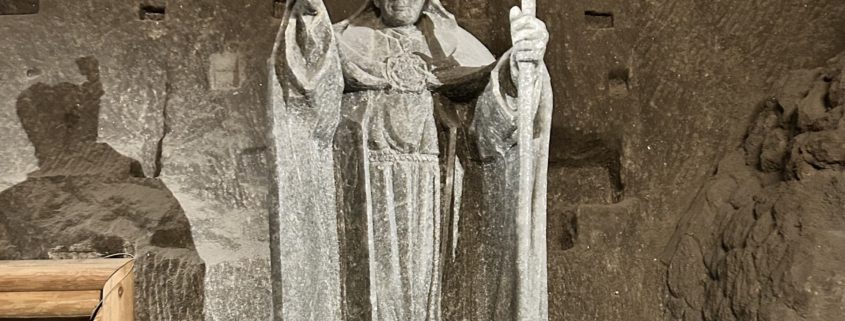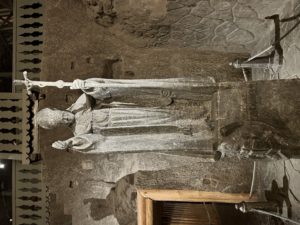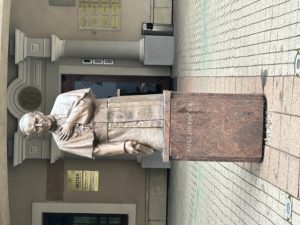Pope Saint John Paul II and Reality vs Perception
By Andrew Emerson
Pope John Paul II is a figure whose legacy continues to loom over the modern state of Poland and the expanded Catholic world. When you travel to Poland you will feel him looming over you. As the statues and portraits erected in the squares and hung upon the street corners seem to follow you no matter where you go. He was a pivotal figure within the Solidarity movement and of Polish resistance against foreign invaders. The bishop of Krakow is a man who is revered by older generations and staunch Catholics. His legacy is one that is intertwined into the fabric of the modern Polish identity. His importance is undeniable, but some harsh critics paint a very different picture of this man of God. Now this begs the question: does the importance he played in paving the way for a new Poland outweigh the suffering that was caused and covered up underneath his tenure?
It is important to understand why John Paul II is not just a regular religious figure and why he held so much sway over Poland. John Paul II was elected to the papacy on October 16th 1978, before this he was the bishop of Krakow where the future pope was beloved by the populace of the city. It is often spoken of how he was a “man of the people ” and was available to hear the plights of many of the citizens and offer his council to them. John Paul II moved quickly upward through the ranks of the Catholic church as his efforts were recognized. Throughout his papacy he would be a crucial figure for the solidarity movement. He was a very open critic of the communist government’s state atheism policies and became a very central figure in the revolutions that would bring this government to its end. John Paul II was also a vocal critic of apartheid, the Gulf war and subsequent invasion of Iraq. For much of his time as the leader of the Catholic church, Pope John Paul II was widely beloved and hailed in the west as the man who saved Poland from communism. The first president of post-communist Poland is credited with saying “Without him there is no solidarity”. His pivotal role in the revolutions in the 1980s is not to be understated. When I traveled to the European Center for Solidarity in Gdansk I discovered one of the last rooms in the exhibit is a shrine to Pope John Paul II. This was uniquely striking, because personally coming from an American Catholic background, John Paul II is not remembered as fondly abroad. After this first revelation I began to see John Paul II everywhere and it became increasingly evident he played a special role here.
Towards the end of his Papacy, widespread allegations were being made against the Catholic church about a conspiracy to protect pedophilic priests within their ranks. As the criticisms became more widespread the pressure began to mount on the elderly and frail John Paul II. Juliusz Paetz the Archbishop of Poznan was accused of molesting multiple young boys and while initially Pope John Paul II accepted his resignation and sanctioned him and took away Paetz’s ability to practice, later on it was said these sanctions were lifted and Paetz still had power within Rome. It soon became very clear to millions of Catholics not just in Poland, but around the world that there was a systemic defense of these priests and that the church higher ups were aware and actively participating in the defense of these men. This realization sent shockwaves through Poland with many of the older generation refusing to believe John Paul’s involvement or knowledge of the extent. While younger people have become completely disillusioned with the church and more openly critical of the space, John Paul II takes up in public life as a result of these scandals.
Today John Paul II is a figure shrouded in controversy with some saying his image must be scrubbed from the fabric of Polish culture because of the crimes he covered up and others who say his importance and role is much too great as a figure for Poland to be ignored. The issue here is the idolization of John Paul II and how there are few churches which do not have his portrait hanging within their walls. He is still absolutely vindicated in a public forum and his image and vindication has led to some historical revisionism and some outright denying the Catholic church’s role in covering up pedophilic assaults. John Paul II’s role in the Polish psyche has become a cancer on the soul of the nation. To defend his likeness, is to ignore the roles he played in a disgusting cover-up and the silencing of thousands of victims. This is a horrible reality for the Polish people to grapple with. The destruction of a national hero and the condemnation that comes with it can be incredibly disheartening for the populace. Something that was once a great unifier has now split people apart without a clear solution of how to remedy this divide. An important thing to recognize is; John Paul II did not spearhead solidarity and its success is not directly attributable to him. The pope was a central figure and gave many hope during these harrowing times, but it is solidarity that defined John Paul II and not John Paul II that defined solidarity. It is possible to recognize the importance of faith to the Polish people and Polish resistance while understanding the harm that was caused by these institutions. It is my stance that to begin this process of healing it is necessary to take down the idols of the man who did the damage.





